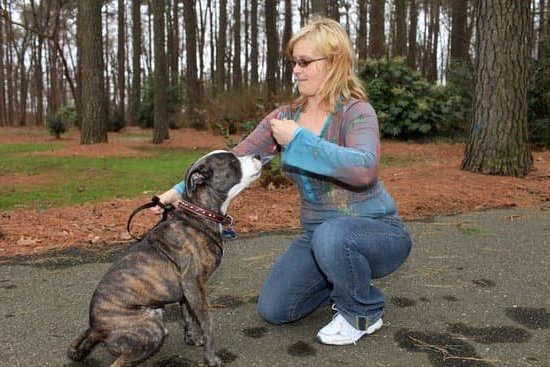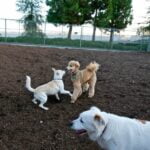If you are a pet parent of an energetic dog, you know that managing their high energy levels can be quite challenging. In this article, we will explore how to train energetic dogs effectively to ensure they are well-behaved and balanced pets. Understanding the unique traits and tendencies of energetic dog breeds is crucial for successful training, as genetics play a significant role in a dog’s behavior and temperament.
We will delve into the importance of regular exercise for managing an energetic dog’s behavior and preventing destructive behaviors caused by pent-up energy. Additionally, we will discuss various ways to provide mental stimulation for energetic dogs, such as puzzle toys, obedience training, and interactive games. Consistency in training methods and routines for energetic dogs, as well as the effectiveness of positive reinforcement techniques, will also be highlighted in this comprehensive guide.
Furthermore, we will provide strategies for redirecting an energetic dog’s energy into productive activities and address management techniques for handling their behavior within the home. Lastly, we will explore the option of seeking professional trainers or behaviorists for help in training an energetic dog and the benefits of specialized guidance for this specific type of dog.
Whether you have a border collie, Australian shepherd, or any other active breed, this article aims to equip you with the knowledge and tools necessary to train your energetic best friend effectively.
The Importance of Exercise
Regular exercise is crucial for managing the behavior of energetic dog breeds such as border collies, huskies, and Australian shepherds. These breeds have been selectively bred for generations to have high energy levels and require a lot of physical activity to keep them happy and prevent destructive behaviors.
Without adequate exercise, energetic dogs can become bored, anxious, and even aggressive. This is why it’s essential for owners to understand the significance of regular exercise in managing their energetic dog’s behavior.
One of the most effective ways to ensure that an energetic dog gets enough exercise is by taking them for daily walks or runs. Ideally, these walks should be at least 30 minutes long and include opportunities for the dog to run off-leash in a safe area. In addition to walks, activities such as hiking, swimming, or playing fetch can also help burn off excess energy and keep an energetic dog mentally stimulated.
Another important aspect of exercising an energetic dog is providing them with opportunities for socialization and play. Taking a high-energy dog to a dog park where they can interact with other dogs can provide much-needed mental stimulation and prevent boredom. Additionally, engaging in interactive games such as Frisbee or agility training can not only exhaust their energy but also strengthen the bond between the owner and their furry friend.
In addition to physical exercise, mental stimulation is also vital for managing an energetic dog’s behavior. Providing puzzle toys or engaging in obedience training sessions can challenge their minds and prevent destructive behaviors caused by pent-up energy. It’s essential to remember that a tired dog is a well-behaved dog, so making sure they get sufficient exercise and mental stimulation is key to training energetic dogs effectively.
Mental Stimulation
Energetic dogs require both physical and mental stimulation to keep them happy and healthy. Mental stimulation is just as important as physical exercise for these breeds, as it helps prevent boredom and destructive behaviors. There are several ways to provide mental stimulation for energetic dogs, including the use of puzzle toys, obedience training, and interactive games.
Puzzle Toys
Puzzle toys are a great way to challenge an energetic dog’s mind while providing entertainment. These toys often require the dog to solve a puzzle in order to access a treat or toy hidden inside. This can help keep the dog engaged and focused, preventing boredom and destructive behaviors that may result from excess energy.
Obedience Training
Obedience training is not only beneficial for teaching a dog basic commands and manners but also for providing mental stimulation. Energetic dogs often thrive on learning new tasks and performing them successfully. By incorporating obedience training into a daily routine, owners can engage their energetic dogs’ minds while also reinforcing positive behaviors.
Interactive Games
Interactive games, such as fetch or tug-of-war, can provide mental stimulation while also allowing the dog to burn off excess energy. These games offer a combination of physical activity and problem-solving skills, making them ideal for energetic breeds. Playing these games with your dog regularly can help satisfy their need for mental stimulation and prevent boredom-related behavioral issues.
Incorporating puzzle toys, obedience training, and interactive games into a daily routine can effectively provide mental stimulation for energetic dogs. These activities not only engage the dog’s mind but also promote bonding between the owner and their pet. Understanding how to train energetic dogs through mental stimulation is essential for keeping them happy and well-behaved.
Consistency in Training
Training an energetic dog requires consistency and patience. Energetic dog breeds, such as the Border Collie, Australian Shepherd, and Labrador Retriever, are known for their high energy levels and require regular mental and physical stimulation to prevent boredom and destructive behaviors. Here are some strategies on how to train energetic dogs effectively:
1. Establish a Routine: Create a consistent daily schedule for your energetic dog, including designated times for feeding, exercise, training sessions, and playtime. Dogs thrive on routine and structure, so providing a predictable schedule can help manage their behavior.
2. Use Clear and Simple Commands: When training an energetic dog, it’s essential to use clear and simple commands to avoid confusion. Consistency in the language you use will help your dog understand what is expected of them. For example, if you use the command “sit” to ask your dog to sit down, make sure everyone in the household uses the same command.
3. Practice Patience: Training an energetic dog requires patience and understanding. It’s important to remain calm and consistent during training sessions, as frustration or impatience can lead to confusion for the dog. Remember that positive reinforcement techniques, such as using treats or praise when your dog successfully follows a command, can be highly effective in encouraging desired behaviors.
In summary, consistency in training methods and routines is crucial when it comes to training energetic dogs. By establishing a routine, using clear commands, practicing patience, and incorporating positive reinforcement techniques into your training sessions, you can effectively manage an energetic dog’s behavior and set them up for success. If you’re struggling with training your energetic dog on your own, seeking professional help from a certified trainer or behaviorist can provide specialized guidance tailored to your specific needs.
Positive Reinforcement
Understanding Positive Reinforcement
Positive reinforcement works by associating desired behaviors with a reward, such as treats, toys, or verbal praise. When a dog performs a behavior that you want to encourage, immediately rewarding them reinforces the likelihood of that behavior happening again. This encourages the dog to focus on what they should do rather than what they shouldn’t do.
Training Techniques
When training an energetic dog using positive reinforcement, it’s important to be consistent in your rewards and praise. Whether it’s basic obedience training or more complex tasks, consistently offering rewards when the dog behaves as desired helps them understand what is expected of them. For example, if you’re teaching a high-energy breed to walk on a leash without pulling, reward them with a treat or praise when they walk calmly by your side.
Using positive reinforcement also involves timing – the reward should be given immediately after the desired behavior occurs so that the dog understands exactly what they are being rewarded for. This clear association between the behavior and the reward helps reinforce the desired actions and encourages the energetic dog to repeat those behaviors in the future.
Bonding and Trust
In addition to motivating and encouraging desired behaviors, positive reinforcement also strengthens the bond between you and your energetic dog. By consistently rewarding good behavior with treats or praise, you build trust and deepen your relationship with your pet.
This trust contributes to better communication between you and your dog during training sessions and everyday interactions. With this foundation of trust established through positive reinforcement techniques, you’ll find that training an energetic dog becomes more manageable and rewarding for both of you.
Redirecting Energy
One of the most effective ways to train energetic dogs is by redirecting their energy into productive activities. This not only helps to manage their high energy levels but also provides mental and physical stimulation, which is essential for their overall well-being. Some popular activities for redirecting an energetic dog’s energy include agility training, nose work, and other stimulating exercises.
Agility training involves teaching a dog to navigate through a variety of obstacles, such as tunnels, jumps, weave poles, and A-frames. Not only does this activity provide physical exercise, but it also requires mental focus and problem-solving skills. Many energetic dogs thrive in agility training as it allows them to channel their energy in a fun and challenging way.
Nose work is another excellent activity for energetic dogs. It taps into their natural instinct to use their sense of smell to search for objects or substances. By engaging in nose work activities, dogs can burn off excess energy while using their cognitive abilities to locate specific scents. This type of mental stimulation can be particularly beneficial for breeds known for their high intelligence and endless energy.
In addition to agility training and nose work, there are many other stimulating exercises that can help redirect an energetic dog’s energy in a positive way. These may include interactive games, advanced obedience training, or even specialized sports such as flyball or dock diving. The key is to find activities that not only challenge the dog physically but also engage their mind in a constructive manner.
| Activity | Benefits |
|---|---|
| Agility Training | Physical exercise, mental focus, problem-solving skills |
| Nose Work | Natural instinct engagement, cognitive abilities utilization |
| Interactive Games | Mind engagement, bond-strengthening with owner |
Management Techniques
Energetic dogs can often be a handful to manage, especially when it comes to their behavior at home. However, there are several effective management techniques that can help pet owners navigate the challenges of living with a high-energy dog. Crate training is one such method that can provide a safe and secure space for an energetic dog, as well as aid in housebreaking and preventing destructive behaviors when unsupervised.
Setting boundaries is another crucial aspect of managing an energetic dog’s behavior in the home. This involves establishing clear rules and limitations for your dog, such as restricting access to certain areas of the house or teaching them not to jump on furniture. Consistency is key when it comes to enforcing these boundaries, and positive reinforcement should be used to encourage good behavior.
In addition to setting boundaries, providing physical and mental outlets for excess energy is essential for managing an energetic dog’s behavior at home. Regular exercise, interactive games, and obedience training can help channel your dog’s energy in productive ways and prevent boredom-induced misbehavior. Mental stimulation through puzzle toys or nose work activities can also keep your dog engaged and mentally sharp.
Providing an outlet for physical energy not only ensures that your dog stays healthy but also helps prevent destructive behavior caused by built-up energy levels. By incorporating these management techniques into your daily routine, you can create a harmonious living environment with your energetic canine companion.
| Management Techniques | Benefits |
|---|---|
| Crate Training | Provides a safe space for the dog while aiding housebreaking |
| Setting Boundaries | Establishes clear rules and limitations; encourages consistency through positive reinforcement |
| Physical and Mental Outlets | Prevents boredom-induced misbehavior; keeps the dog engaged and mentally sharp. |
Seeking Professional Help
In conclusion, training an energetic dog can be a challenging but rewarding experience. Understanding the specific needs and traits of energetic breeds is vital in creating a successful training plan. Regular exercise and mental stimulation are essential in managing an energetic dog’s behavior and preventing destructive tendencies.
Consistency in training methods is crucial for these high-energy dogs, as well as using positive reinforcement techniques to motivate and encourage desired behaviors. It’s important to redirect their energy into productive activities such as agility training or interactive games to provide them with both physical and mental outlets for their excess energy.
While there are many management techniques that can be implemented at home, seeking professional help from trainers or behaviorists specializing in energetic dogs can provide invaluable guidance. These experts can offer personalized advice and training plans tailored to the specific needs of the individual dog, setting both the owner and pet up for success. By following these tips and seeking professional help when necessary, owners can effectively train their energetic dogs, leading to a happy and well-behaved canine companion.
Frequently Asked Questions
How Do You Train an Energetic Dog?
Training an energetic dog requires consistency, patience, and plenty of exercise. Engaging in regular obedience training, providing mental stimulation through interactive toys, and incorporating daily walks or runs can help channel their energy in a positive way.
Is It Possible to Train a Hyperactive Dog?
Yes, it is possible to train a hyperactive dog with the right approach. Utilizing positive reinforcement techniques, creating a structured routine, and providing outlets for physical and mental stimulation can help manage and improve their behavior over time.
How Do You Calm Down a Hyper Dog?
To calm down a hyper dog, it’s important to provide plenty of physical exercise to tire them out. Additionally, incorporating mental stimulation through puzzle toys or training exercises can also help redirect their excess energy. Establishing a consistent daily routine and using calming techniques such as massage or gentle pressure can also be beneficial in calming a hyper dog.

Welcome to the blog! I am a professional dog trainer and have been working with dogs for many years. In this blog, I will be discussing various topics related to dog training, including tips, tricks, and advice. I hope you find this information helpful and informative. Thanks for reading!





